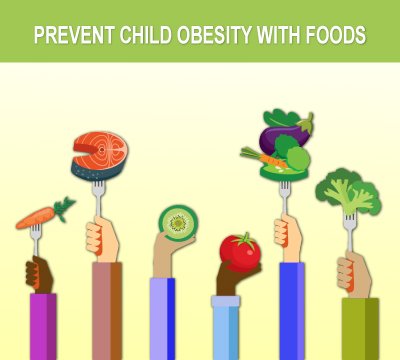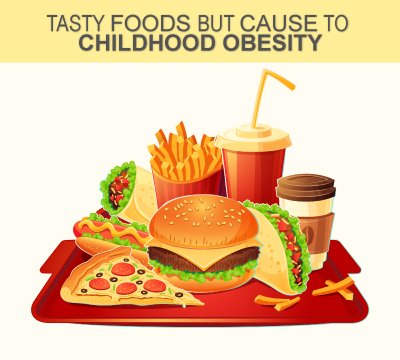Childhood obesity is a pressing public health concern, affecting millions of children worldwide. According to the Centers for Disease Control and Prevention (CDC), in the U.S. alone, one in five children between the ages of 2 and 19 struggles with obesity. This excess weight can lead to a cascade of health problems later in life, including heart disease, type 2 diabetes, and even some cancers.
But fear not, parents! By making informed choices about your child’s diet and incorporating regular physical activity, you can significantly reduce their risk of childhood obesity. Let’s dive into the world of healthy eating for children, explore some of the biggest contributors to weight gain, and equip you with the knowledge to raise a healthy, happy child.

Unveiling the Culprits: Foods that can Tip the Scales
While genetics can play a role, childhood obesity is most often caused by an imbalance between calories consumed and calories burned. Here are some common dietary culprits that can contribute to weight gain in children:
1. Sugary Drinks: These beverages are loaded with empty calories and little to no nutritional value. Popular options like soda, sports drinks, and fruit juices are packed with added sugars, which can lead to blood sugar spikes, increased hunger, and weight gain. The American Heart Association recommends limiting added sugars to no more than 25 grams per day for children under 9 years old and 36 grams per day for older children and teens.
2. Processed Snacks: Potato chips, cookies, crackers, and other processed snacks are often loaded with unhealthy fats, sodium, and artificial ingredients. These can be addictive and leave your child feeling unsatisfied, leading to overeating.
3. Fast Food: Fast food restaurants are notorious for their high-calorie, high-fat, and high-sodium meals. The oversized portions and abundance of processed ingredients can quickly derail a healthy diet for your child.
4. Excessive Added Sugars: Added sugars are sneaky and can be found lurking in many seemingly healthy foods like breakfast cereals, yogurt, and condiments. Be sure to read food labels carefully and opt for options with lower sugar content.
5. Refined Grains: White bread, pasta, and pastries are stripped of their fiber and nutrients during processing. This can lead to blood sugar spikes and leave your child feeling hungry soon after eating.
6. Fried Foods: French fries, chicken nuggets, and other fried foods are high in unhealthy fats and calories. Limit these types of foods and opt for healthier cooking methods like baking, grilling, or roasting.
7. Fruit Juices: While some fruit juices offer essential vitamins, they often lack the filling fiber found in whole fruits. This can lead to a quick spike in blood sugar and leave your child feeling hungry again shortly after.
8. Large Portions: Even healthy foods can contribute to weight gain if consumed in excess. Be mindful of portion sizes and encourage your child to listen to their hunger cues.
9. Lack of Fruits and Vegetables: Fruits and vegetables are packed with essential vitamins, minerals, and fiber that keep your child feeling full and energized. Aim for a rainbow of colors on your child’s plate to ensure they’re getting a variety of nutrients.
10. Skipping Meals: Skipping meals can disrupt your child’s metabolism and lead to overeating at the next meal. Focus on regular meals and healthy snacks throughout the day to keep your child’s energy levels stable.

Building a Healthy Plate: Championing Fruits, Vegetables, and Whole Grains
Now that we’ve identified some of the dietary foes, let’s focus on the champions of a healthy weight:
- Fruits and Vegetables: Fill half your child’s plate with a colorful array of fruits and vegetables. These nutrient-dense powerhouses provide essential vitamins, minerals, and fiber to keep your child feeling full and energized.
- Whole Grains: Swap refined grains for whole grains like brown rice, quinoa, and whole-wheat bread. Whole grains offer sustained energy and are packed with fiber, which keeps your child feeling full longer.
- Lean Protein: Include lean protein sources like chicken, fish, beans, and lentils in your child’s diet. Protein helps build and repair tissues and keeps your child feeling satisfied.
- Healthy Fats: Don’t be afraid of healthy fats! Include sources like avocado, nuts, and seeds in moderation. Healthy fats are essential for brain development and overall health.
- Low-fat Dairy: Low-fat dairy products like milk and yogurt provide essential calcium for strong bones and teeth.
Empowering Your Child: Building Healthy Habits as a Team
Childhood is a crucial time to establish healthy habits that will last a lifetime. By working together as a family, you can create a supportive environment that fosters a love for healthy eating and regular physical activity. Here are some tips to empower your child and make healthy choices a fun family adventure:
- Get Your Kitchen Grooving: Involve your child in meal planning and preparation. Take them grocery shopping and let them pick out new fruits and vegetables to try. Cooking together in the kitchen is a great way to bond and teach your child valuable life skills.
- Make it a Rainbow Party: Encourage your child to explore the vibrant world of fruits and vegetables. Challenge them to try a new color of the rainbow each week. Get creative with food presentation – cut vegetables into fun shapes or arrange fruit skewers for a visually appealing snack.
- Read Food Labels Together: Turn grocery shopping into a learning experience. Teach your child how to read food labels and understand the difference between healthy and unhealthy ingredients. Empower them to make informed choices about the foods they put in their bodies.
- Portion Patrol Partners: Discuss appropriate portion sizes with your child. Use bowls and plates that are the right size for their age and avoid serving directly from large packages. Let your child listen to their hunger cues and stop eating when they feel satisfied.
- Become Hydration Heroes: Water is essential for good health and can help curb cravings. Make water the go-to beverage at home and encourage your child to carry a reusable water bottle throughout the day.
- Limit Screen Time: Excessive screen time can contribute to a sedentary lifestyle and unhealthy snacking habits. Set clear limits on screen time and encourage active play instead.
- Move Your Bodies Together: Make physical activity a fun family affair. Go for bike rides, take walks in nature, play tag in the park, or dance to your favorite music. Find activities that everyone enjoys and make exercise a regular part of your family routine.
- Celebrate Non-Scale Victories: Focus on the positive changes you see in your child, not just the numbers on the scale. Celebrate their willingness to try new foods, their participation in physical activities, and their overall enthusiasm for a healthy lifestyle.
- Be a Positive Role Model: Children learn by example. Make healthy choices for yourself and demonstrate the importance of a balanced diet and regular exercise in your own life.
Remember, change takes time and there will be setbacks along the way. Be patient, celebrate the wins, and focus on creating a supportive and encouraging environment where your child feels empowered to make healthy choices.

Building a Support System: Beyond the Dinner Table
In addition to the strategies mentioned above, consider these tips to create a lasting impact on your child’s health:
- Partner with Your Pediatrician: Talk to your child’s pediatrician about healthy weight management strategies and growth patterns. They can provide personalized guidance and address any underlying medical concerns.
- Get Schooled: Many schools offer nutrition education programs. Encourage your child to participate and learn about healthy eating habits in a classroom setting.
- Find a Fitness Buddy: Does your child have a friend who enjoys being active? Encourage them to play together and participate in physical activities.
- Lead by Example: Create a family culture that values healthy living. Make healthy choices the norm, not the exception.
Finishing Touch
Childhood obesity is a complex issue, but one that can be addressed through a combination of healthy eating habits, regular physical activity, and a supportive family environment. By working together and making small, sustainable changes, you can empower your child to develop a healthy relationship with food and exercise, setting them on the path to a happy and healthy life.
